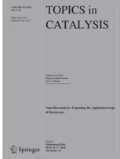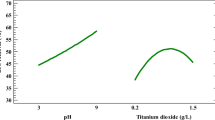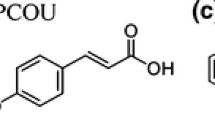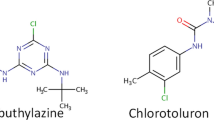Abstract
This work presents the main results regarding the use of solar heterogeneous photocatalysis with TiO2 on the removal of Benzophenone-1 and Benzophenone-2 (BP1 and BP2) in aqueous samples at lab and pilot scale. BP1 and BP2 are two UV-filters that have been classified as potential endocrine disruptors, and their presence in water has been reported by different researches. Experiments were conducted at lab scale using simulated sunlight radiation, while at pilot scale a solar compound cylinder-parabolic (CCP) collector and direct sunlight were employed. Effects of catalyst concentration and solution pH on contaminants elimination were assessed. Pollutants were completely removed at lab conditions in just 60 min of reaction, while under pilot scale tests elimination was around 90.0% in 360 min. Mineralization of treated samples was around 60%. In general, it was found that the photo-generation of hydroxyl (HO·) radicals contributes to BP1 and BP2 removal, and that higher doses of TiO2 could have an inhibitory effect. Additionally, presence of some inorganic ions on the aqueous matrix (drinking water) used in the pilot-scale tests would be associated to a reduction on the extent of pollutants degradation, which together with aspects such as the type of reactor and the atmospheric and climate conditions would limit the process efficiency in comparison with results at lab-scale experiments.








Similar content being viewed by others
References
Vione D, Caringella R, De Laurentiis E et al (2013) Phototransformation of the sunlight filter benzophenone-3 (2-hydroxy-4-methoxybenzophenone) under conditions relevant to surface waters. Sci Total Environ 463–464:243–251
Blüthgen N, Zucchi S, Fent K (2012) Effects of the UV filter benzophenone-3 (oxybenzone) at low concentrations in zebrafish (Danio rerio). Toxicol Appl Pharmacol 263:184–194
Kim S, Choi K (2014) Occurrences, toxicities, and ecological risks of benzophenone-3, a common component of organic sunscreen products: a mini-review. Environ Int 70:143–157
Błędzka D, Gmurek M, Gryglik M et al (2010) Photodegradation and advanced oxidation of endocrine disruptors in aqueous solutions. Catal Today 151:125–130
Tobajas M, Belver C, Rodriguez JJ (2017) Degradation of emerging pollutants in water under solar irradiation using novel TiO2-ZnO/clay nanoarchitectures. Chem Eng J 309:596–606
Fernández Ibáñez P (2003) Propiedades coloidales de partículas de TiO2: Aplicación al tratamiento fotocatalítico solar de aguas. Universidad de Granada, Tesis para optar al título de Doctor en Ciencias Físicas
Moctezuma E, Leyva E, Aguilar CA et al (2012) Photocatalytic degradation of paracetamol: intermediates and total reaction mechanism. J Hazard Mater 243:130–138
Malato S, Blanco J, Alarcón DC et al (2007) Photocatalytic decontamination and disinfection of water with solar collectors. Catal Today 122:137–149
Alalm MG, Tawfik A, Ookawara S (2015) Degradation of four pharmaceuticals by solar photo-Fenton process: kinetics and costs estimation. J Environ Chem Eng 3:46–51
Berkani M, Bouhelassa M, Bouchareb MK (2019) Implementation of a venturi photocatalytic reactor: optimization of photodecolorization of an industrial azo dye. Arab J Chem 12:3054–3063
Zúñiga-Benítez H, Peñuela GA (2017) Solar lab and pilot scale photo-oxidation of ethylparaben using H2O2 and TiO2 in aqueous solutions. J Photochem Photobiol A 337:62–70
Zúñiga-Benítez H, Muñoz-Calderón A, Peñuela GA (2018) Removal of a mix of benzophenones and parabens using solar photo-Fenton and a cylinder parabolic collector in aqueous solutions. J Environ Chem Eng 6:7347–7357
Standard Methods for the Examination of Water and Wastewater (2017), 23er ed. American Public Health Association, Washington, DC
Kanakaraju D, Glass BD, Oelgemöller M (2018) Advanced oxidation process-mediated removal of pharmaceuticals from water: a review. J Environ Manage 219:189–207
Carabin A, Drogui P, Robert D (2015) Photo-degradation of carbamazepine using TiO2 suspended photocatalysts. J Taiwan Inst Chem Eng 54:109–117
Baran W, Adamek E, Makowski A (2008) The influence of selected parameters on the photocatalytic degradation of azo-dyes in the presence of TiO2 aqueous suspension. Chem Eng J 145:242–248
Giraldo AL, Peñuela GA, Torres-Palma RA et al (2010) Degradation of the antibiotic oxolinic acid by photocatalysis with TiO2 in suspension. Water Res 44:5158–5167
He T, Tsui MMP, Tan CJ et al (2019) Comparative toxicities of four benzophenone ultraviolet filters to two life stages of two coral species. Sci Total Environ 651:2391–2399
CAS (2019) SciFinder Database
Zhang J, Nosaka Y (2014) Mechanism of the OH radical generation in photocatalysis with TiO2 of different crystalline types. J Phys Chem C 118:10824–10832
Santiago DE, Doña-Rodríguez JM, Araña J et al (2013) Optimization of the degradation of imazalil by photocatalysis: comparison between commercial and lab-made photocatalysts. Appl Catal B 138–139:391–400
Tao C, Jia Q, Han B, Ma Z (2020) Tunable selectivity of radical generation over TiO2 for photocatalysis. Chem Eng Sci 215:115438
De Laat J, Le TG (2006) Effects of chloride ions on the iron(III)-catalyzed decomposition of hydrogen peroxide and on the efficiency of the Fenton-like oxidation process. Appl Catal B 66:137–146
Le Truong G, De Laat J, Legube B (2004) Effects of chloride and sulfate on the rate of oxidation of ferrous ion by H2O2. Water Res 38:2383–2393
Giri AS, Golder AK (2015) Decomposition of drug mixture in Fenton and photo-Fenton processes: comparison to singly treatment, evolution of inorganic ions and toxicity assay. Chemosphere 127:254–261
Deng J, Shao Y, Gao N et al (2013) Degradation of the antiepileptic drug carbamazepine upon different UV-based advanced oxidation processes in water. Chem Eng J 222:150–158
Spasiano D, Marotta R, Malato S et al (2015) Solar photocatalysis: materials, reactors, some commercial, and pre-industrialized applications. A comprehensive approach. Appl Catal B 170–171:90–123
Rubio-Clemente A, Chica E, Peñuela GA (2018) Photovoltaic array for powering advanced oxidation processes: sizing, application and investment costs for the degradation of a mixture of anthracene and benzo[a]pyrene in natural water by the UV/H2O2 system. J Environ Chem Eng 6:2751–2761
Acknowledgements
Authors want to thank Universidad de Antioquia for its financial and administrative support.
Author information
Authors and Affiliations
Corresponding author
Ethics declarations
Conflict of interest
There are no conflicts of interest to declare.
Additional information
Publisher's Note
Springer Nature remains neutral with regard to jurisdictional claims in published maps and institutional affiliations.
Electronic supplementary material
Below is the link to the electronic supplementary material.
Rights and permissions
About this article
Cite this article
Zúñiga-Benítez, H., Peñuela, G.A. Solar-Induced Removal of Benzophenones Using TiO2 Heterogeneous Photocatalysis at Lab and Pilot Scale. Top Catal 63, 976–984 (2020). https://doi.org/10.1007/s11244-020-01332-w
Published:
Issue Date:
DOI: https://doi.org/10.1007/s11244-020-01332-w




